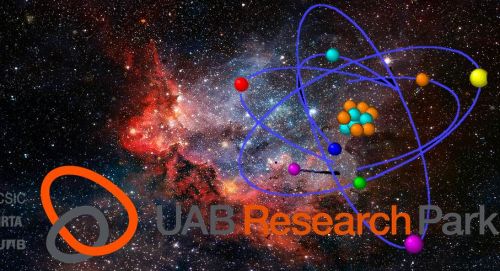
26/07/2017
The UAB Research Park: from the infinitely small to the infinitely big
The UAB Research Park: from the infinitely small to the infinitely big
The UAB Research Park (PRUAB), of which the Barcelona Synchrotron Park is a partner and sponsor of the ideas generation program, offers this month news related to two of its research centers working at both ends of the scale of dimensions: the Catalan Institute of Nanoscience and Nanotechnology (ICN2) and the Institute of High Energy Physics (IFAE).
The infinitely small
A research team led by Jordi Sort, ICREA Research Professor and Lecturer of the Department of Physics at the Universitat Autònoma de Barcelona, with the collaboration of the Catalan Institute for Nanoscience and Nanotechnology (ICN2), has developed a nanoporous material based on a copper-nickel alloy, with a structure similar to that of a sponge, but with a separation between pores (i.e., thickness of the pore walls) of only 5 or 10 nanometres. In other words, the walls of the pores contain room for only a few dozens of atoms: this new material allows handling and storing information using very low energy.
“This represents a new paradigm in the energy saving of computers and in computing and handling magnetic data in general”, says Jordi Sort.
The infinitely big
This month, the IFAE celebrates its anniversary: 25 years exploring the cosmic and high energy frontiers, in order to solve fundamental questions about the universe that still have no answer. The main lines of research, both experimental and theoretical, are particle physics, high energy astrophysics and cosmology. But technological innovation is also present in IFAE in applied physics projects: development of new instrumentation, such as detectors or telescope chambers, medical applications projects, such as new medical imaging systems, and mass data management solutions.
The infinitely small
A research team led by Jordi Sort, ICREA Research Professor and Lecturer of the Department of Physics at the Universitat Autònoma de Barcelona, with the collaboration of the Catalan Institute for Nanoscience and Nanotechnology (ICN2), has developed a nanoporous material based on a copper-nickel alloy, with a structure similar to that of a sponge, but with a separation between pores (i.e., thickness of the pore walls) of only 5 or 10 nanometres. In other words, the walls of the pores contain room for only a few dozens of atoms: this new material allows handling and storing information using very low energy.
“This represents a new paradigm in the energy saving of computers and in computing and handling magnetic data in general”, says Jordi Sort.
The infinitely big
This month, the IFAE celebrates its anniversary: 25 years exploring the cosmic and high energy frontiers, in order to solve fundamental questions about the universe that still have no answer. The main lines of research, both experimental and theoretical, are particle physics, high energy astrophysics and cosmology. But technological innovation is also present in IFAE in applied physics projects: development of new instrumentation, such as detectors or telescope chambers, medical applications projects, such as new medical imaging systems, and mass data management solutions.
More news
19/06/2014
ALBA synchrotron welcomes the one thousandth researcher
12/06/2014
€ 1.365 billion of foreign investment in the Catalan industry in 2013
03/06/2014
Barcelona Synchroton Park booth at the BioKorea 2014 exhibition in Seoul
27/05/2014
The new Barcelona Synchrotron Park bus shuttle completes its first six months
20/05/2014
SENER opens in the Barcelona Synchrotron Park its new corporate headquarters in Catalonia
15/05/2014
MATGAS, Air Products' leading R&D centre worldwide









